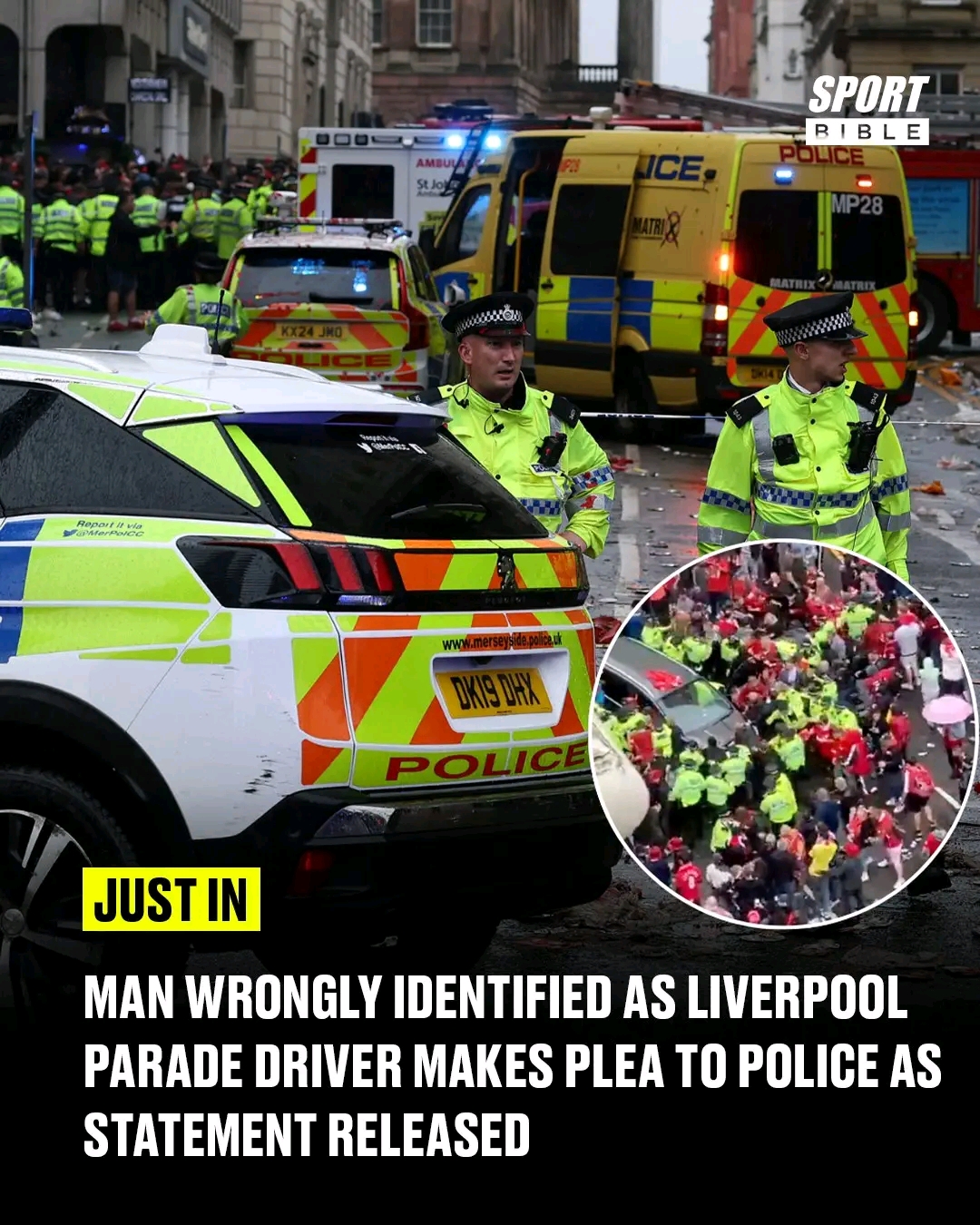Liverpool Parade Incident: Wrongly Identified Man’s Plea for Police Action

The jubilant celebrations that swept through Liverpool following the club’s Premier League title triumph were dramatically overshadowed by a tragic incident that unfolded on Monday evening. What began as a day of pure joy and communal celebration for thousands of Liverpool Football Club supporters quickly transformed into a scene of confusion, concern, and ultimately, tragedy. The events that transpired on Water Street in Liverpool’s city centre not only left dozens injured but also sparked a troubling case of mistaken identity that has highlighted the dangerous consequences of social media speculation during ongoing police investigations.
The incident, which occurred at approximately 6pm on Monday evening, has sent shockwaves throughout the Liverpool community and beyond. As the city’s streets filled with red-clad supporters celebrating their team’s remarkable achievement, few could have anticipated that the day would end with such devastating consequences. The aftermath has revealed not only the immediate impact of the incident itself but also the secondary trauma experienced by individuals wrongly identified as perpetrators through the rapid spread of misinformation on social media platforms.
Liverpool’s Premier League title parade was scheduled to be a momentous occasion for the city and its residents. Thousands of supporters had gathered throughout the day to celebrate their team’s success, with fans lining the streets in a sea of red jerseys, scarves, and banners. The atmosphere was electric, filled with the kind of communal joy that only comes with sporting triumph of this magnitude. Children and adults alike had taken to the streets, many having traveled from across Merseyside and beyond to be part of this historic celebration.
The parade route had been carefully planned by city officials and police to accommodate the expected crowds while ensuring public safety. Water Street, a major thoroughfare in Liverpool’s city centre, was one of the key locations where fans had congregated to catch a glimpse of their heroes and participate in the festivities. The street, normally bustling with regular city traffic, had been transformed into a celebration zone where supporters could safely gather and share in the collective euphoria of their team’s achievement.
However, as the evening progressed and the official parade activities began to wind down, the mood of the celebration was about to change dramatically. At around 6pm, just as many fans were beginning to make their way home or to local establishments to continue their celebrations, a serious incident occurred that would cast a shadow over what should have been one of the happiest days in recent Liverpool history.
The incident that occurred on Water Street was captured on mobile phone video by witnesses, footage that would later circulate widely on social media platforms. The video showed a vehicle driving through the area where Liverpool supporters had gathered, resulting in multiple people being struck. The sudden and shocking nature of the incident created immediate chaos in what had moments before been a peaceful celebration.
Emergency services responded rapidly to the scene, with paramedics, police officers, and other first responders arriving within minutes of the incident being reported. The professional and swift response of these emergency services undoubtedly prevented what could have been an even more tragic outcome. The area was quickly secured, and medical attention was provided to all those who had been injured in the incident.
Merseyside Police immediately launched an investigation into the circumstances surrounding the incident. Within hours of the event occurring, they had made an arrest, taking a 53-year-old white British man into custody. The suspect was identified as being from the West Derby area of Liverpool, and he was transported to a local police station where he remained for questioning throughout the following days.
The speed with which the arrest was made demonstrated the efficiency of the police response and their commitment to ensuring that justice would be served for those affected by the incident. However, the arrest also marked the beginning of a complex investigation that would need to carefully examine all aspects of what had occurred, including the driver’s intentions, the circumstances leading up to the incident, and the full extent of the injuries sustained by the victims.
The medical response to the incident was comprehensive and immediate, reflecting the preparedness of emergency services for large-scale events in the city. David Kitchin, representing the North West Ambulance Service, provided detailed information about the medical response during a press conference held on Monday evening. His statement painted a clear picture of the scale of the medical emergency that had unfolded.
According to Kitchin’s report, ambulance crews treated a total of 20 patients at the scene for what were classified as minor injuries. These individuals, while injured, did not require hospital treatment and were able to receive the care they needed on-site before being released. This group represented the majority of those who were directly affected by the incident, and their relatively minor injuries, while still traumatic, represented the best possible outcome given the circumstances.
However, the situation was more serious for others involved in the incident. A total of 27 patients required transportation to local hospitals by ambulance for further medical treatment. This larger group included individuals whose injuries were more severe and required the specialized care that could only be provided in a hospital setting. The range of injuries varied considerably, reflecting the chaotic nature of the incident and the different ways in which people were affected.
Most concerning of all were the two patients who sustained what medical professionals classified as serious injuries. Among these two individuals was a child, adding an particularly tragic dimension to an already devastating incident. The involvement of a young person in such circumstances inevitably heightened the emotional impact of the event on the community and underscored the random and senseless nature of what had occurred.
The medical response continued throughout the evening and into the following days, with hospital staff providing ongoing care to those who had been injured. The professionalism and dedication of the medical teams involved ensured that all victims received the best possible care during their time of need
In the immediate aftermath of the incident, as police began their investigation and medical teams cared for the injured, a troubling secondary problem began to emerge. Social media platforms, which had earlier in the day been filled with joyous celebrations of Liverpool’s title success, quickly became breeding grounds for speculation and misinformation about the identity of the driver responsible for the incident.
Despite clear warnings from Merseyside Police urging the public to refrain from speculation while the investigation was ongoing, various social media users began sharing names, photographs, and personal information of individuals they believed to be connected to the incident. This type of online vigilantism, while perhaps motivated by a desire for justice, created serious problems for innocent individuals who found themselves wrongly identified as the perpetrator.
The speed with which misinformation can spread on social media platforms was demonstrated in stark terms as false identifications circulated rapidly among thousands of users. Within hours of the incident occurring, multiple individuals found their names and faces associated with the tragic events, despite having no connection whatsoever to what had happened on Water Street.
This phenomenon highlighted one of the most problematic aspects of social media culture in crisis situations: the tendency for users to share unverified information in the heat of the moment, often without considering the potential consequences for the individuals whose lives could be dramatically affected by such actions
Among those wrongly identified as the driver was Peter Cunningham, a 54-year-old man from Huyton in Liverpool, whose experience exemplifies the personal trauma that can result from social media misinformation. Cunningham found himself thrust into an nightmare scenario through no fault of his own, becoming the target of public suspicion and anger directed at someone who had committed a serious crime.
The impact on Cunningham’s life was immediate and severe. As his name and personal information circulated on social media platforms, he began receiving phone calls from family members and friends who had seen the allegations and were seeking clarification. The emotional toll of having to repeatedly explain to loved ones that he was not involved in such a serious incident cannot be understated.
Cunningham’s situation was made even more distressing by the fact that he was at work during the time of the incident, providing him with a clear alibi that should have protected him from such accusations. However, the nature of social media speculation meant that factual details like his whereabouts during the incident were irrelevant to those sharing his information online.
Speaking to the BBC via FaceTime, Cunningham made his desperation clear: “It’s not me. I’m in work – the police need to give the name out because I’m getting accused.” His words reflected not only his frustration with the situation but also his understanding that only official police action could effectively end the speculation that was causing him such distress.
The psychological impact of being wrongly associated with such a serious crime extended beyond the immediate embarrassment and confusion. Cunningham expressed genuine fear about how the situation might escalate, telling reporters: “Family members and friends are ringing and asking me, but it could get a whole lot worse, the police need to do something.”
This fear was well-founded, as history has shown that online mob justice can sometimes spill over into real-world harassment and even violence directed at innocent individuals. The potential for the situation to deteriorate further made Cunningham’s plea for police intervention all the more urgent and understandable.
## Police Protocol and Public Pressure
Cunningham’s call for police to release the name of the actual suspect highlighted a fundamental tension between standard police procedures and the practical need to protect innocent individuals from online harassment. Merseyside Police found themselves in a difficult position, balancing their commitment to following established protocols with the recognition that their silence was inadvertently allowing misinformation to flourish.
Standard police procedure in the United Kingdom typically prevents the release of suspects’ names until formal charges have been filed. This protocol exists for important legal and practical reasons: it protects the rights of individuals who may ultimately be found innocent, prevents prejudicial publicity that could affect future legal proceedings, and ensures that investigations can proceed without external interference.
However, the digital age has created new challenges for these traditional approaches to police communication. The speed with which misinformation can spread online, and the potential harm it can cause to innocent individuals, has forced police departments to reconsider how they balance transparency with procedural requirements.
A spokeswoman for Merseyside Police addressed this dilemma in a statement to the BBC: “We have arrested a 53-year-old man from West Derby and he remains in police custody where he continues to be interviewed.” While this statement provided some factual information about the case, it fell short of the specific details that Cunningham and others were seeking to clear their names
The police response also included renewed appeals for the public to avoid speculation about the identity of the suspect. These appeals, while well-intentioned, highlighted the challenge that law enforcement agencies face in the social media age: how to effectively discourage harmful online behavior while maintaining the integrity of their investigations
The tragic incident occurred against the backdrop of what should have been one of the most joyous occasions in Liverpool Football Club’s recent history. The Premier League title that the team was celebrating represented the culmination of years of hard work, dedication, and the unwavering support of fans who had waited decades for such success.
Liverpool’s journey to the Premier League title had been followed by millions of supporters around the world, but for the local community, the achievement held special significance. The club is deeply embedded in the cultural identity of the city, and major successes are celebrated not just as sporting achievements but as sources of civic pride that bring the community together.
The title parade was designed to allow fans to share in this historic moment, providing an opportunity for the community to come together in celebration. The fact that such a positive community event was marred by tragedy made the incident all the more shocking and difficult to process for those involved.
The contrast between the joy of the early celebrations and the horror of the evening’s events created a complex emotional landscape for Liverpool supporters and city residents. Many found themselves struggling to reconcile their happiness about the team’s success with their concern and anger about what had happened to fellow fans
In the days following the incident, the Liverpool community demonstrated the resilience and solidarity for which the city is renowned. Despite the trauma of what had occurred, supporters came together to offer support to those who had been injured and to process the events collectively.
Local organizations, including the football club itself, reached out to provide assistance to those affected by the incident. This support took various forms, from practical help with medical expenses to emotional support for those struggling to cope with the trauma they had experienced.
The response also included efforts to combat the misinformation that had spread on social media platforms. Community leaders and prominent local figures used their platforms to discourage speculation and to emphasize the importance of allowing the police investigation to proceed without interference.
These efforts reflected the values that the Liverpool community holds dear: solidarity in times of crisis, support for those in need, and a commitment to justice through proper legal channels rather than vigilante action
As the investigation into the incident continued, Merseyside Police worked methodically to gather evidence and build a comprehensive understanding of what had occurred. The 53-year-old suspect remained in custody, where he continued to be interviewed by detectives working to establish the full circumstances of the incident.
The investigation involved multiple aspects, including forensic examination of the vehicle involved, analysis of witness statements, review of CCTV footage from the area, and detailed medical reports on the injuries sustained by victims. This comprehensive approach was necessary to ensure that when the case eventually came to court, prosecutors would have all the evidence needed to secure a conviction.
The complexity of the investigation meant that it would likely take considerable time before formal charges could be filed and the case could proceed through the legal system. This timeline, while frustrating for those seeking quick answers, reflected the thoroughness required to ensure that justice would ultimately be served.
The incident and its aftermath provided important lessons about the challenges of maintaining justice and protecting innocent individuals in the digital age. The speed with which misinformation spread and the harm it caused to people like Peter Cunningham demonstrated the urgent need for better systems to combat false information during crisis situations.
Social media platforms faced scrutiny for their role in allowing harmful misinformation to circulate, raising questions about their responsibilities to monitor and remove false content during sensitive situations. The incident highlighted the tension between free speech principles and the need to protect individuals from harm caused by false accusations.
The case also underscored the importance of media literacy and critical thinking skills among social media users. The willingness of many users to share unverified information without considering its accuracy or potential consequences contributed significantly to the problems experienced by wrongly identified individuals.
The incident that occurred during Liverpool’s Premier League title parade represents a tragic convergence of random violence and the dangers of digital-age misinformation. What began as a celebration of sporting achievement became a complex crisis involving physical trauma, criminal investigation, and the secondary victimization of innocent individuals through online harassment.
Peter Cunningham’s experience serves as a stark reminder of how quickly an ordinary person’s life can be disrupted by false accusations spread through social media. His plea for police action to clear his name reflected not just personal desperation but also a broader need for society to develop better approaches to handling information during crisis situations.
The incident ultimately raised important questions about police communication strategies, social media platform responsibilities, and individual user behavior online. While the immediate focus remained on supporting the victims and ensuring that justice was served through proper legal channels, the broader implications of what occurred will likely influence how similar situations are handled in the future.
As Liverpool continues to process this tragedy and work toward healing, the community’s response has demonstrated both the best and worst aspects of human nature: the tendency toward hasty judgment and harmful speculation, but also the capacity for solidarity, support, and resilience in the face of unexpected trauma. The lessons learned from this incident will hopefully contribute to better protection for both crime victims and innocent individuals caught up in the dangerous dynamics of social media speculation.















